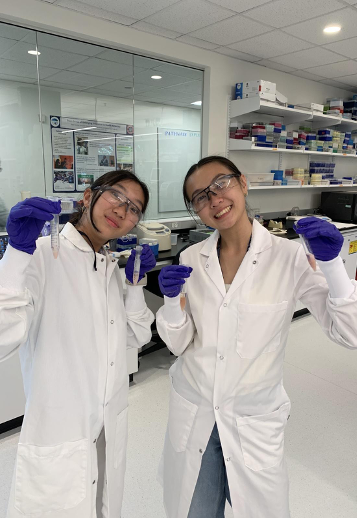Izabella D.
- SEP

- Sep 18, 2025
- 3 min read
Tiny Animals, Big Discoveries:
Learning About Cancer Research at Fred Hutch
Introduction
This summer, I had the opportunity to be part of the Fred Hutch High School Explorers Program, where I learned about cancer research, medicine, and the many ways science can change lives. One of the biggest highlights for me was exploring the animal model labs and discovering how scientists use CRISPR, a gene-editing tool, to study cancer. This experience opened my eyes to the connection between basic research and future treatments.
Animal Models in Cancer Research
During this program, we toured several animal labs where we learned how researchers study tiny organisms such as C. Elegans (worms), Drosophila (fruit flies), and Danio Rerio (zebrafish). At first, it was surprising to realize that creatures so small could be used to study something as complex as cancer. But I quickly learned that these animals are incredible for research. C. Elegans are transparent and have simple body plans, which makes it easy to see how cells develop and respond to changes. Drosophila share many genetic similarities with humans, making them powerful for studying mutations. Danio rerio, or zebrafish, have embryos that are see-through, allowing scientist to literally watch how cells grow, divide, and even turn cancerous. These models reminded me that progress in medicine often starts in unexpected places, and even the tiniest organisms can play a role in saving lives.

C. Elegan being injected with a mutation
CRIPSR: Editing Genes Like a Recipe
One of the most exciting parts of the program was learning about CRISPR. CRISPR is like a pair of molecular scissors scientists can use to “cut and paste” pieces of DNA. It allows researchers to edit genes with precision, changing or repairing DNA sequences that can cause disease. In our program, we learned how CRSIPR can be used in animal models. For example, researchers might use it to create fruit flies with specific mutations so they can better understand how cancer develops. To help explain this concept, my group and I created a poster with a sandwich theme called the “CRISPR Deli”. Just like you can add, remove, or swap out ingredients in a sandwich, CRISPR lets scientists edit genes in living organisms.

My group’s CRISPR poster project
Why This Experience Inspired Me
Learning about animal models and CRISPR inspired me because it showed how creative and innovative science can be. Before this program, I mostly thought of medicine in terms of hospitals and patient care. But through Explorers, I saw how deeply research connects to medicine and how breakthroughs in the lab eventually reach patients in need. It was amazing to realize that the work happening in a lab today could someday lead to a treatment that saves lives. This experience also reminded me why I want to pursue a career in healthcare: to make a difference for patients, but also to stay curious about the science that drives medical progress.
Conclusion
Being part of the Explorers Program showed me that behind every medical advance are countless hours of basic research, creativity, and persistence. Whether its studying zebrafish or using CRISPR to unlock new treatments, each step brings us closer to saving lives. This program inspired me to continue pursuing my dream of working in medicine and reminded me that even the smallest discoveries can lead to the biggest changes.

My Explorers group along with Dr. Goode and our two volunteers







Comments